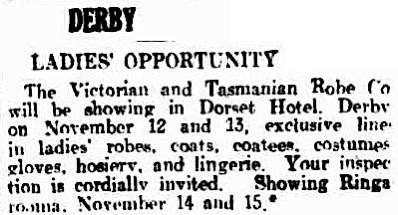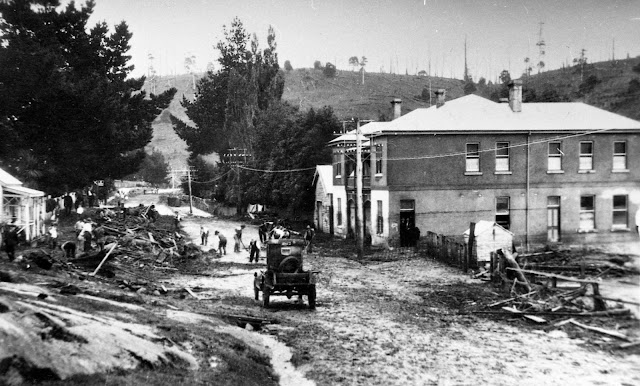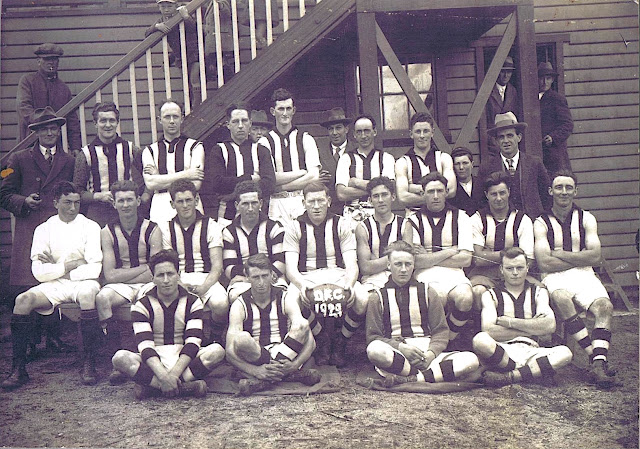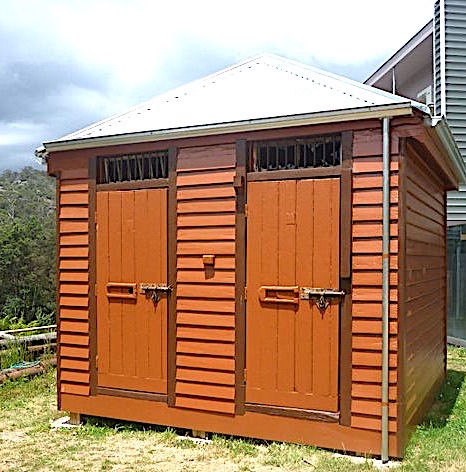Derby, Tasmania, is about 90 minutes drive (95km) north-east of Launceston. The town has transformed from a former tin-mining town, to a place renown for its mountain-biking trails.
Pyemmairrener Aboriginal People
Nine palawa language groups lived in Tasmania in small clan groups when first colonised. However, there is a lack of information about the similarities and differences between thees groups.
Aboriginal people arrived in Tasmania about 40,000 years ago. Then the end of the Ice Age about 11, 00 years ago caused sea levels to rise and separated Tasmania from the Australian mainland. (New Guinea was also
connected to Australia until about 10,000 years ago, and people could simply walk down Cape York)
These "mobs" or sub-tribes group themselves into several broad divisions, more properly deserving the name of "tribes". In these larger divisions separate languages or dialects were spoken, the vocabularies of which were widely different, as appears from Milligan's Vocabulary. Minor differences of dialect must have been numerous, for Robert Clark, the catechist, states that on his arrival at the Flinders' Settlement in 1834, eight or ten different languages or dialects were spoken amongst the 200 natives then at the establishment, and that the blacks were "instructing each other to speak their respective tongues." |
| Nicolas Baudin & N M Petit of Tasmanian Aboriginal, 1807 (The French spent 10 weeks exploring Tasmania, charting the east coast and frequently interacting with Tasmanian Aboriginal people) |
The writings of James Backhouse Walker about the early settlement and Aboriginal inhabitants of Tasmania, published in 1902, became a standard authority. Read
here
Friendly mission: the Tasmanian journals and papers of George Augustus Robinson, 1829-1834, contains information about many aspects of Aboriginal life.
Palawa kani is the constructed Tasmanian Aboriginal language, using words salvaged from the 14 languages.
1642
Dutch Captain Abel Tasman is believed to be the first European to land on Tasmania in 1642. The Dutch did not see the Aboriginal people, but they heard a sound “resembling a trumpet or a little gong” and trees cut with notches for climbing. George Augustus Robinson explained in 1830 that these notches were for hunting possums.
The Dutch also saw many hollow trees “burnt deep inside, above the roots, while the earth had become as hard as flint because of the continual effect of the fire
 |
| Abel Janszoon Tasma (1603 – 10 October 1659) was a Dutch seafarerand explorer |
1700s
French ships
Mascarin and
Marquis de Castries, captained by Marion Dufresne, were the first European to encounter the Aboriginal Tasmanians. Read
hereIn March 1773, while on James Cook’s second voyage, the
Adventure, under Captain Tobias Furneaux, landed in Tasmania, spending 10 days there. James Burney was the first British person to land ashore on the south coast. Read
journal
A French expedition led by Bruni d'Entrecasteaux in 1792–93, while searching for the La Pérouse expedition, made detailed surveys and charts of the southern coast of Tasmania.
On James Cook's 3rd voyage, in January 1777, his two ships,
Resolution &
Discovery, dropped anchor offshore at Adventure Bay on Bruny Island, Tasmania. He described the Aboriginal dwellings as “little sheds or hovels built of sticks, and covered with bark."
In 1788, Captain William Bligh anchored the
Bounty in Adventure Bay, Tasmania and Third Lieutenant George Tobin pained twenty watercolours of the area.
 |
| Native Hut, or Wigwam, of Adventure Bay. George Tobin, watercolour on paper, c. 1792. |
1790s
In 1798, George Bass and Matthew Flinders, in the sloop
Norfolk, circumnavigated Van Diemen's Land. Bass described an Aboriginal shelter using a fallen branch covered with bark. Flinders later produced the multi-volume
A Voyage to Terra Australis.
 |
| In 1798, George Bass and Matthew Flinders sailed the sloop Norfolk from Sydney whether Van Diemen's Land joined to the mainland of Australia |
1800s
Napoleon Bonaparte commissioned a voyage of discovery led by Admiral Nicolas Baudin, who visited Tasmania in 1802. French plans to invade the British Colony were later revealed (1.) Baudin’s journal was not translated and published in English until 1974.
 |
| The Baudin expedition of 1800 to 1803. The expedition started with two ships, Géographe, captained by Baudin, and Naturaliste captained by Jacques Hamelin |
1850s
The area was surveyed by James Scott in 1855.
1870s
In 1874, George Renison Bell, a devout Quaker, discovered payable alluvial tin at Boobyalla, which led to the tin-mining industry around Derby.
The Brothers' Home at Derby was established in 1876 by the Krushka brothers. The Brothers Mine, gave the town its original name: Brother’s Home.
The winner of the 1876 Melbourne Cup, Briseis, inspired the name of the The Briseis Tin Mine Company at Derby.
1880s
The original Dorset Hotel in Derby was built in 1883 of timber.
The National Bank of Tasmania at Derby
opened in 1888 to serve the tin mining industry but closed in the 1970s.
1890s
By the 1890s, the population of Derby was more than 3,000.
 |
| The Australian handbook (incorporating New Zealand, Fiji, and New Guinea) and shippers' and importers' directory. (1895) |
Getting goods to Derby "....involved tedious
journeys by bullock waggon or dray over
almost im-passable tracks. The usual means of
communication was by ketch or small
steamer from Launceston to Bridport,
Boobyalla, or St. Helens, and from there,
after landing in small boats, bullock or
horse conveyances were hired for the
journey to the fields, while goods were
carried by pack horses." (
*)
1900s
W T Doolan was
granted a license for the Imperial Hotel at Derby in December 1900.
The Briseis Water Race was completed in 1902. It was an engineering achievement of 48km length to channel water to Derby for mining. (Travelled through forests and rocky terrain with four ‘great’ siphons (pipes) constructed to transport the water over rivers and across gullies)
* |
| Daily Telegraph (Launceston, Tas. : 1883 - 1928), Saturday 10 May 1902 |
 |
| Daily Telegraph (Launceston, Tas. : 1883 - 1928), Saturday 10 May 1902 |
 |
| BRISEIS TIN MINE : SLUICING FACE. (Derby, TAS). Australasian (Melbourne, Vic. : 1864 - 1946), Saturday 28 February 1903 |
 |
| BIUSEIS TIN MINE : VIEW FROM KRUSKA'S FACE, DERBY, TASMANIA, Australasian (Melbourne, Vic. : 1864 - 1946), Saturday 28 February 1903 |
 |
| Derby, TAS, 1906-1930, Spurling, NLA |
 |
| Examiner (Launceston, Tas. : 1900 - 1954), Monday 14 November 1910 |
The current Dorset Hotel, was built in 1911 and withstood the flood that destroyed much of the
town in 1929.
 |
| North-Eastern Advertiser (Scottsdale, Tas. : 1909 - 1954), Tuesday 11 August 1914 |
WWI
 |
| Mr. Spottswood was born at Sheffield (Tas.) in 1893. He entered the service of the National Bank of Tasmania Ltd. at Beaconsfield in 1907, and was transferred to Derby in 1911. In 1913, he joined the staff of the Briseis Tin and General Mining Co. Ltd., Derby, and was in its employ until the outbreak of the war, when he enlisted as a private in the 12th Battalion, seeing service on Gallipoli (he was wounded at the landing) and in France. He rose in the ranks until he gained a captaincy in 1918, and won the M.C. for distinguished service. On his return to Tasmania he took up his old position with the Brisels Company Examiner (Launceston, Tas. : 1900 - 1954) |
 |
| Informal portrait of 4753 Private (Pte) Henry Joseph Brown, 12th Battalion, of Derby, Tasmania (originally of Ringarooma). A farmer prior to enlistment, Pte Brown enlisted on 16 November 1915 and embarked on HMAT Ballarat (A79) on 18 February 1916. He was killed in action on 19 August 1916 at Mouquet Farm, and is buried at the London Cemetery and extension, Longueval. AWM |
In 1915, school enrolments were 236.
Derby station opened on 15 March 1919.
1920s
 |
| Daily Telegraph (Launceston, Tas. : 1883 - 1928), Monday 12 November 1923 |
Briseis (Cascade Dam) was constructed between 1924 – 1926 and had a height of 70ft.
 |
| Derby Town Hall, TAS, North-Eastern Advertiser (Scottsdale, Tas. : 1909 - 1954), Friday 26 November 1926 |
 |
| North-Eastern Advertiser (Scottsdale, Tas. : 1909 - 1954), Friday 26 November 1926 |
 |
| Mercury (Hobart, Tas. : 1860 - 1954), Tuesday 5 April 1927 |
In April 1929, after five days of rain, fourteen people died, when the Briseis Dam at Derby burst its banks.
Houses were swept away, and all the bridges on the Ringarooma River between Derby and the sea were also swept away.
Senior Constable William Taylor was
awarded the Royal Humane Society Medal and the King George Medal for bravery for saving eight stranded miners from the devastating floods.
 |
| Examiner (Launceston, Tas. : 1900 - 1954), Friday 5 April 1929 |
 |
| Mr. Inverarity's hlouse as it settled after being shifted ;bodily for 50 yards. It was under this building that the baby Whiting's body was found (Derby TAS). Examiner (Launceston, Tas. : 1900 - 1954), Monday 8 April 1929 |
 |
| BRISEIS RESCUE BOAT.-The BriseisRood disaster took toll of 14 lives. Eight others would have perished but for the fact that Mr. W. Muckridge (in the picture) had arrived only two days before with this boat, and Senior Constable Taylor, by using it, rescued eight miners from an "island," one by one. When the disaster happened Mr. Muckridge's boat Was caught in the swirl of waters, and he saved it only by risking his life.Mercury (Hobart, Tas. : 1860 - 1954), Thursday 25 April 1929 |
 |
| Derby, TAS, Weekly Courier, April 10, 1929 (after the flood) |
The collapse of the Cascade Dam and Great Depression, led to the decline of the town.
 |
| Derby Football Team 1929, TAS |
1930s
The Briseis Dam, was renamed the Cascade Dam, and rebuilt in 1936.
 |
| Briseis mine workings at Derby. The dam for the supply of water. Rock is' being blasted fromthc hillside to strengthen the sides of the dam. The lower left picture shows the dam from the intake side.Mercury (Hobart, Tas. : 1860 - 1954), Saturday 16 May 1936 |
1940s and WWII
 |
| Private C. E. A. Gibbons, 2/12th Battalion, and his son Private C. E. Gibbons, 2/Ist Machine Gun Battalion, of Derby, who are with the A.I.F. in England. /Examiner (Launceston, Tas. : 1900 - 1954) Fri 9 Aug 1940 |
 |
| North-Eastern Advertiser (Scottsdale, Tas. : 1909 - 1954), Friday 24 September 1943, |
1950s
 |
| Examiner (Launceston, Tas. : 1900 - 1954), Friday 24 February 1950 |
 |
| All that remains of the two-srory Imperial Hotel and a nearby shop which were gutted bya spectacular fire. at Derby, TAS, Examiner (Launceston, Tas. : 1900 - 1954), Friday 24 February 1950 |
 |
| Examiner (Launceston, Tas. : 1900 - 1954), Saturday 6 May 1950 |
The Briseis race was still in use for mining purposes in the 1950s by the Ormus Tin Mine.
Derby is the administrative centre of the Ringarooma Municipality, in which farming, sawmilling, and mining are the main occupations.
* |
| Mercury (Hobart, Tas. : 1860 - 1954), Wednesday 14 April 1954 |
 |
| RACING to save £2300 worth of tin oxide in the sluice boxes above the workings of the Briseis mine at Derby yesterday, these five men had a heavy and anxious job. The sluices were undermined by flood waters from the Cascade River and were threatened with collapse. Examiner (Launceston, Tas. : 1900 - 1954), Wednesday 29 October 1952 |
1980s
The old gaol, built in 1889, was
moved to the Derby Tin Mine Centre in 1981.
 |
| The old Derby gaol, TAS, is now restored and in the grounds of the Derby Schoolhouse Museum |
1990s
The railway closed in April 1992.
2000s
An old "Shanty Town" museum was demolished in 2007, to make way for the Tin Centre.
 |
| An old "Shanty Town" museum was demolished in 2007, to make way for the Tin Centre. Derby, TAS |
In 2013, the restoration project began for the Derby Grandstand.
 |
| The original grandstand was built in 1922 at Derby Park, TAS, and was moved to its present location in 1942 (before) |
 |
| the original grandstand was built in 1922 at Derby Park, TAS, and was moved to its present location in 1942 (after) |
The Blue Derby mountain bike network opened in 2014.
Concern about logging near mountain bike trails in 2016. Many of Derby’s trails follow old water races.
2017: Enduro World Series announced it was coming to Derby.
The Derby River Derby was not continued in 2018.
 |
| The Derby River Derby, Derby, TAS |
In 2018, a rundown two-bedroom cottage built in 1900, sold for $1.3 million.
Around Derby
 |
| National Bank of Tasmania, built 1888, then was a Westpac branch through to 1991, Derby, TAS |
 |
| The Derby Schoolhouse Museum is a local history museum situated in the heritage school building, which was built in 1897, TAS |
 |
| Derby, TAS |
 |
| The Dorset Hotel's original building (1883) was replaced in 1911, Derby, TAS |
 |
| The Derby Town Hall, TAS, was built in 1923 |
 |
| Mountain bike trails, Derby, TAS |
 |
| Mountain bike trails, Derby, TAS |
 |
| The entrance to one of the old mines, Derby, TAS (part of bike trails) |
 |
| Old miner's cottage, Derby, TAS |
 |
| Derby's General Store, TAS, built 1896 |
 |
| The lake in Derby, TAS, known as Briseis Hole to the locals |
 |
| Floating sauna, Derby, TAS |
 |
| Mount Paris Dam, on the Cascade River south of Derby, Tasmania, was a water source for a nearby tin mines (built using only shovels and wheelbarrows in 1937) The abandoned Mt Paris Dam, sits on the Cascade River, just south of the town Derby in northeast Tassie |
Things To Do and Places To Go
Derby Schoolhouse Museum - The Derby Schoolhouse Museum is located on Main Street in Derby
The Tin Dragon Interpretation Centre & Cafe, 55 Main st, Derby, TAS

































































































